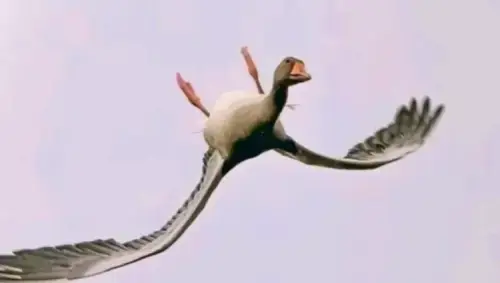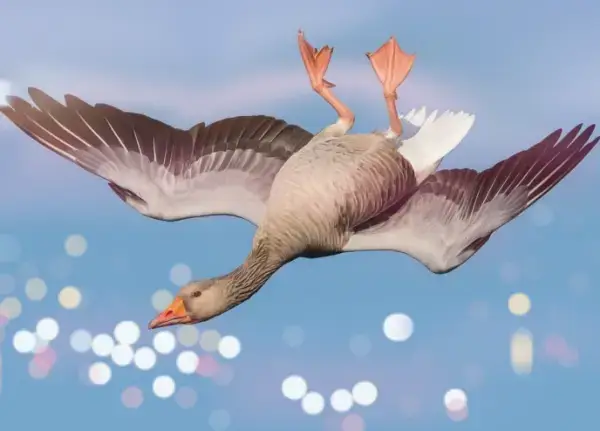Geese. Imagine a crisp autumn afternoon. A V-formation of geese slices across the vast, blue canvas of the sky, their powerful wingbeats a steady, hypnotic rhythm.
It’s a scene of perfect, natural order, a symbol of seasonal change and unwavering purpose. Then, suddenly, one of the geese does something utterly bizarre.
It twists in mid-air, flipping completely upside down. For a few heart-stopping moments, it continues to fly forward with its belly to the sky and its back to the earth before righting itself as if nothing happened.
To the casual observer, it might look like a mistake, a momentary loss of control, or perhaps even a playful, showboating gesture. But what you’ve just witnessed is no accident. It is a highly sophisticated and life-saving aerodynamic maneuver known to ornithologists as “whiffling.”
This seemingly comical behavior has been a source of fascination and study for over a century. It is not a sign of distress but rather a demonstration of incredible skill a complex aerial technique that serves multiple critical purposes in the life of a goose.
Far from being a random tumble, whiffling is a controlled, deliberate action that showcases the bird’s mastery of the air, blending instinct with the pure physics of flight.
To truly understand why a goose would fly upside down, we must delve into the worlds of aerodynamics, predator-prey dynamics, and the intricate social lives of these remarkable birds.
Geese, Mechanics of a Controlled Fall.
What is Whiffling?
At its core, whiffling is a rapid, intentional flip around the bird’s longitudinal axis. The goose executes a swift roll, inverting its body 180 degrees. While its body is upside down, its wings continue to flap, but the orientation is now reversed.
Crucially, the goose twists its neck and head a full 180 degrees as well, allowing it to keep its eyes fixed on its flight path and maintain perfect spatial awareness. From below, it looks like a goose flying normally but with its body attached the wrong way up.
The physics behind this maneuver is both simple and brilliant.
A bird’s wing is an airfoil, shaped to generate lift. In normal flight, air moves faster over the curved upper surface of the wing than the flatter bottom surface, creating a pressure difference that pushes the bird upward, defying gravity.
When a goose whiffles, it turns this principle on its head—literally. By inverting its wings, it completely disrupts the flow of air that generates lift. The wings, instead of pushing the bird up, now act like spoilers or airbrakes, creating drag and a downward force.
The result is a dramatic and incredibly rapid loss of altitude. The goose essentially transforms from a graceful glider into a controlled falling object, plummeting towards the ground at a speed far greater than a normal descent. However, it does so without significantly reducing its forward momentum.
Think of it as a pilot executing a maneuver called a “sideslip,” or a skier digging their edges into the snow to scrub speed before a turn. The goose is “slipping” down through the air, using its own body to brake against the sky.
Once it reaches the desired altitude, a quick counter-roll returns it to its normal orientation, ready for a smooth landing.
The Need for Speed.
Why Whiffle?
Scientists have identified several key situations where this extraordinary skill becomes not just useful, but vital for survival.
1. The Precision Landing: An Aerial Handbrake.
The most common reason for whiffling is to prepare for a landing. Geese, particularly large species like Canada or Greylag geese, are heavy birds with significant momentum. After a long migratory flight, a flock might spot a perfect resting place—a secluded lake, a marsh rich with food, or a harvested grain field.
Often, they approach the location with too much height or speed. If they were to attempt a standard, gradual descent, they would overshoot their target entirely, costing them precious energy to circle back.
Whiffling provides the perfect solution. The flock can maintain its approach speed until the last moment, then, in a stunningly coordinated display, several birds may begin to whiffle simultaneously. They drop from the sky like a cascade of falling leaves, shedding altitude in seconds.
This allows them to land with pinpoint accuracy, right in the center of their chosen sanctuary. For a bird that relies on finding safe, resource-rich stopover points during a grueling migration, the ability to “hit the brakes” in mid-air is an invaluable tool.
2. The Dance with Death: Evading Predators.
Life in the wild is a constant battle for survival, and for a large, relatively slow bird like a goose, danger often comes from above. Eagles, peregrine falcons, and other large birds of prey are formidable hunters that often target geese during their long migratory journeys.
These predators hunt by using incredible speed and predicting their prey’s flight path to execute a deadly strike.
Whiffling is a goose’s evolutionary trump card in this high-stakes game. When a predator dives, the goose can execute its disorienting flip. The sudden, chaotic tumble completely breaks the smooth, predictable trajectory the attacker was anticipating.
The predator’s brain, hardwired to calculate intercepts based on stable flight, is momentarily discombobulated. That split-second of confusion is all the goose needs. The erratic, falling motion makes it an almost impossible target to lock onto.
It’s a life-saving evasive maneuver that can mean the difference between life and death, allowing the goose to escape the raptor’s talons. Hunters have also noted this behavior for generations, observing geese using whiffling to dodge shotgun pellets by abruptly changing their direction and altitude.
3. Social Signals and Avian Play.
A third, more subtle reason for whiffling may lie in social communication. Observers have noted that whiffling can sometimes appear to be a signal within the flock.
A coordinated whiffle by several lead birds might be a non-verbal cue to the rest of the formation, signaling an imminent landing or a change in direction. In the complex social structure of a goose flock, such clear and visible signals are essential for group cohesion.
Furthermore, some researchers speculate that whiffling might, at times, simply be a form of play. Younger geese, in particular, are often seen whiffling more frequently. This could be practice, honing a crucial skill they will need as adults. Or, it could be a sign of pure exuberance—the simple joy of mastering the air.
Just as young mammals chase and tumble, young birds may engage in aerial acrobatics to test their limits and interact with their peers.
Nature’s Aerobats.
Not Just for Geese.
While geese are the most famous practitioners of whiffling, they are by no means the only ones. Many other bird species employ similar tactics. Various species of ducks, shorebirds like the lapwing (famous for its tumbling aerial displays), and even gulls have been observed performing this maneuver.
However, the large size and powerful wings of geese make their performance the most dramatic and spectacular.
The parallel between whiffling and human aerobatics is striking. Pilots perform maneuvers like the “barrel roll” or the “falling leaf” for similar reasons—to rapidly change altitude or direction. But where a human pilot relies on complex machinery and extensive training, the goose performs these feats instinctively.
It is a testament to the power of evolution, which has gifted these birds with a body and a brain perfectly attuned to the dynamic forces of the sky.
To watch a goose whiffle is to witness a moment of perfect, evolved genius. What appears at first to be a clumsy mistake is, in reality, a masterful display of control, a physical expression of a solution forged over millions of years of adaptation.
It is a reminder that in nature, even the most amusing and unexpected behaviors often have a deep and serious purpose. So the next time you see that V-formation in the sky, watch closely.
You might just catch a glimpse of nature’s finest acrobat, turning the world upside down to survive.





